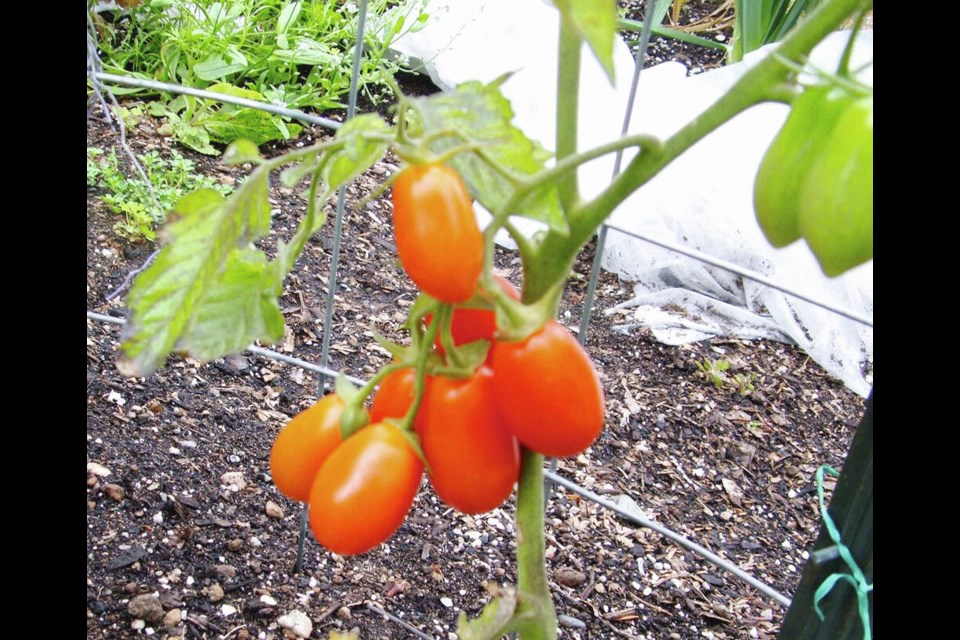The challenges of this hot, dry spring and summer have, of necessity, given rise to innovative, if sometimes stumbling, solutions. Keeping moisture in the soil and preventing the ground from becoming too hot for seeds to germinate have been serious issues this growing season. Protecting plants and seedlings from being damaged by hot sunlight has been another big problem.
Mulches and shading to the rescue.
Mulch. I’ve always found it helpful, even before the weather extremes of recent years, to mulch around major plantings, especially main food crops such as tomatoes, kale, broccoli, cucumbers and carrots, with a high-quality compost, to give them a nourishing boost and to help conserve soil moisture.
Now, that’s not enough. To deflect hot sunlight and further help to keep the soil cool and conserve moisture, straw is my material of choice for adding over the compost layer around and under plantings. Its light colour and slight shine make it a good sunlight deflector. It is lightweight, easy to handle and compostable at the end of the season.
Shade. I’ve been stumbling about a fair bit organizing shade for my seed beds and transplants. My first choice has been sheets of cardboard, because I usually have some on hand for weed suppression on pathways. Propping them up on the sunny side of the kale transplants this spring saved those plants.
I will acquire shade cloth for future seasons, but this year I’ve been scrounging around the garden’s storage areas and in the dark recesses of the garden shed, gathering up various useful items — short wire fencing, wire hoops and various supports from old portable cold frames and so on. Placing sturdy supports in a planting to be protected and then laying sheets of cardboard over them for the hot portion of the day has been a simple and effective cooling technique for short plants such as carrots and beets.
It took me a while to figure out how I could use a length of lightweight curtaining a friend had given me to create shade for plants. A plan came to me as I pulled up the spent shelling-pea vines that had grown on two four-metre lengths of light, 120-cm high wire fencing set one metre apart.
I bought clothes pins at a hardware store and used them to pin the curtaining to the fencing, forming a cloth roof over the space below and leaving panels at either end that can be secured to the ground as further shading (and a bunny barrier). The tunnel formed is now planted with lettuce and endive.
News of the season. Dan Jason of Salt Spring Seeds tells me that his customers have been struggling with diseases and blossom-end rot in their tomatoes. My staked tomatoes look skinny, without their usual leafiness. Still, the Sun Dipper tomatoes have produced fine, early clusters of elongated, flavour-filled little tomatoes.
Gardeners are reporting smaller than usual fruits. My plums and figs are the usual size, but my apples are far smaller than expected at this point in summer. The figs began ripening early, at the end of July rather than mid- to late August.
Cucumbers. The cucumber vines have been almost alarmingly prolific. So many ways to consume them. I’ve been turning my favourite cucumber salad, first encountered during my year in Greece, into a creamy, blended soup. The salad is just chopped cucumber in a mix of yogurt, lemon juice, mashed garlic and a drizzle of olive oil. For the soup, I added sprigs of mint. Blended smooth, it is delicious and refreshing.
More to come: Cucumbers sautéed with herbs (nice with salmon). Cucumber and crumbled feta cheese in a yogurt, sour cream, vinegar, garlic and Dijon-mustard dressing. Cucumber and mango with quinoa, dried currants or cranberries, and toasted sliced almonds in a lemon juice and zest, olive oil and honey dressing.
Icy pleasures. The garden’s frozen strawberries, prune plums and blueberries have become sources for a quick and cooling pick-me-up in the hot weather.
It’s so easy. Put the blueberries, chunks of frozen strawberries or cut-up plum halves in a blender. Add fresh lemon juice, yogurt, and honey or maple syrup. Amounts will depend on the desired sweetness and creaminess.
Blend the mixture smooth. I enjoy some as a partially frozen treat, and freeze the rest to enjoy later.



